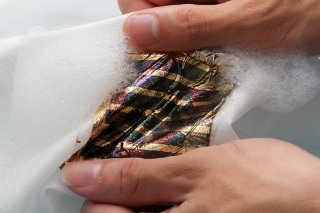Sep 19 2017
Researchers from RIKEN and the University of Tokyo have created a new type of ultra-thin photovoltaic device, coated on both sides with waterproof and stretchable films, which can continue to provide electricity from sunlight even after being immersed in water or being compressed and stretched.
The study published in Nature Energy, could pave the way to wearable solar cells, which will supply power to devices such as health monitors added into clothing.
 Photo of the ultra-thin organic solar cells (Credit: RIKEN)
Photo of the ultra-thin organic solar cells (Credit: RIKEN)
One of the necessities of the Internet of Things—referring to a world where devices of all kinds are linked to the Internet—is the advancement of power sources for a range of devices, including wearable devices. According to Takao Someya, the Head of the research group, these could include sensors that record body temperature and heartbeats, for instance, providing early warning of medical issues. Formerly, attempts have been made to develop photovoltaics that could be added into textiles; however, they missed at least one of the vital properties, long-term stability in water and air, energy efficiency and robustness including resistance to deformation, which are crucial to successful devices.
For the current work, the team developed very thin and flexible organic photovoltaic cells, based on a material known as PNTz4T, which they had created in an earlier research. They placed the device in an inverse architecture, which they had formerly built, onto a 1 µm thick parylene film. The ultra-thin device was then deposited onto acrylic-based elastomer and the top side of the device was coated with an identical elastomer, providing it a coating on both sides to prevent water infiltration.
The elastomer, while permitting light to enter, stopped air and water from seeping into the cells, making them more long-lasting than earlier experiments.
The Researchers then exposed the device to a number of tests, discovering first that it had a robust energy efficiency of 7.9%, generating a current of 7.86 mW/cm2, as the current density was 13.8 mA/cm2 at 0.57 V, based on a simulated sunlight of 100 mW/cm2. To analyze its resistance to water, they immersed it in water for two hours and found that the efficiency reduced by only 5.4%. And to analyze the durability, they subjected it to compression, and discovered that after compressing by almost half for twenty cycles while depositing drops of water on it, it still retained 80% of the original efficiency.
We were very gratified to find that our device has great environmental stability while simultaneously having a good efficiency and mechanical robustness. We very much hope that these washable, lightweight and stretchable organic photovoltaics will open a new avenue for use as a long-term power source system for wearable sensors and other devices.
Kenjiro Fukuda, the RIKEN Center for Emergent Matter Science
Reference
Hiroaki Jinno, Kenjiro Fukuda, Xiaomin Xu, Sungjun Park, Yasuhito Suzuki, Mari Koizumi, Tomoyuki Yokota, Itaru Osaka, Kazuo Takimiya, and Takao Someya, "Stretchable and waterproof elastomer-coated organic photovoltaics for washable electronic textile applications", Nature Energy, doi: 10.1038/s41560-017-0001-3